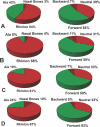Epistaxis first-aid management: a needs assessment among healthcare providers
- PMID: 33573695
- PMCID: PMC7879664
- DOI: 10.1186/s40463-020-00485-8
Epistaxis first-aid management: a needs assessment among healthcare providers
Abstract
Purpose: To perform a needs assessment of epistaxis first-aid measures practiced by family physicians and Emergency Department (ED) staff in London, Ontario, Canada.
Methods: Paper-based multiple-choice questionnaires were distributed to participants. Participant recruitment was conducted in two parts: 1) 28 Emergency Medicine (EM) attending physicians, 21 resident physicians training in the ED, and 26 ED nurses were surveyed while on duty in the ED; 2) 27 family physicians providing walk-in or urgent care and attending a continuing medical education (CME) event were also surveyed. Respondents were asked to identify where to apply compression to the nose and how patients should be positioned during acute epistaxis.
Results: Regarding where to apply compression, 19% of family physicians, 43% of EM physicians, 24% of residents, and 8% of ED nurses responded correctly. Regarding positioning, all groups responded similarly with 54-62% responding correctly. Twenty-one percent of emergency physicians, 19% of residents, 11% of family physicians, and 4% of nurses responded correctly to both questions.
Conclusions: Most family physicians, EM attending physicians, ED nurses, and residents could not correctly identify basic first-aid measures for acute epistaxis. This study identifies an area where knowledge is lacking and the potential for improvement in patient management and education.
Keywords: Compression; Continuing medical education; Epistaxis; First aid; Healthcare professionals; Survey study; Urgent care.
Conflict of interest statement
The authors declare that they have no competing interests.
Figures
Similar articles
-
Assessment of First Aid Measures to Control Epistaxis Among Health Care Providers at Tertiary Care Hospital in Saudi Arabia.Cureus. 2022 Aug 19;14(8):e28155. doi: 10.7759/cureus.28155. eCollection 2022 Aug. Cureus. 2022. PMID: 36148202 Free PMC article.
-
Epistaxis first-aid: a multi-center knowledge assessment study among medical workers.Eur Arch Otorhinolaryngol. 2024 Sep;281(9):4855-4862. doi: 10.1007/s00405-024-08681-2. Epub 2024 May 15. Eur Arch Otorhinolaryngol. 2024. PMID: 38748311
-
Exploring knowledge of first aid in epistaxis-25 years on.PLoS One. 2025 Jan 15;20(1):e0315092. doi: 10.1371/journal.pone.0315092. eCollection 2025. PLoS One. 2025. PMID: 39813210 Free PMC article.
-
Clinical Practice Guideline: Nosebleed (Epistaxis) Executive Summary.Otolaryngol Head Neck Surg. 2020 Jan;162(1):8-25. doi: 10.1177/0194599819889955. Otolaryngol Head Neck Surg. 2020. PMID: 31910122 Review.
-
Use of nasal clips as first aid for anterior epistaxis.Emerg Med J. 2025 Apr 22;42(5):343-344. doi: 10.1136/emermed-2024-214829. Emerg Med J. 2025. PMID: 40081851
Cited by
-
Assessment of First Aid Measures to Control Epistaxis Among Health Care Providers at Tertiary Care Hospital in Saudi Arabia.Cureus. 2022 Aug 19;14(8):e28155. doi: 10.7759/cureus.28155. eCollection 2022 Aug. Cureus. 2022. PMID: 36148202 Free PMC article.
-
Assessment of Public Knowledge and Awareness on First-Aid Management of Epistaxis in Makkah, Saudi Arabia.Cureus. 2023 Oct 30;15(10):e47945. doi: 10.7759/cureus.47945. eCollection 2023 Oct. Cureus. 2023. PMID: 38034274 Free PMC article.
-
Knowledge on First Aid Management of Epistaxis among Medical Students of a Medical College: A Descriptive Cross-sectional Study.JNMA J Nepal Med Assoc. 2024 Apr 30;62(273):327-331. doi: 10.31729/jnma.8580. JNMA J Nepal Med Assoc. 2024. PMID: 39356878 Free PMC article.
-
Assessment of Public Knowledge and Awareness on First-Aid Management of Epistaxis in Qatif Region, Saudi Arabia.Cureus. 2025 Feb 1;17(2):e78323. doi: 10.7759/cureus.78323. eCollection 2025 Feb. Cureus. 2025. PMID: 40034620 Free PMC article.
-
Management of Anterior Epistaxis in the Emergency Department Using Rapid Rhino and Merocel: A Cost Analysis.J Otolaryngol Head Neck Surg. 2025 Jan-Dec;54:19160216251321459. doi: 10.1177/19160216251321459. J Otolaryngol Head Neck Surg. 2025. PMID: 39980298 Free PMC article.
References
-
- American College of Surgeons Committee on Trauma . Advanced trauma life support student course manual. 8. Chicago: American College of Surgeons; 2008.
MeSH terms
LinkOut - more resources
Full Text Sources
Other Literature Sources
Medical



